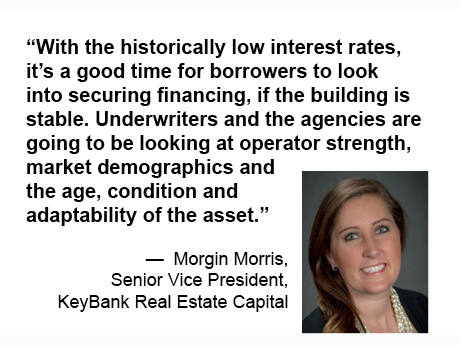Amid the uncertainty of 2020, multifamily real estate portfolios as a whole outperformed expectations. However, seniors housing faced unique operational challenges during a pandemic that has been particularly devastating to older populations. The government-sponsored enterprises (GSEs), Fannie Mae and Freddie Mac, were instrumental in keeping liquidity in the housing market. Entering 2021, the agencies continue their focus on mission-based lending to increase affordable housing, including in the seniors housing sector. Capital markets experts Angela Mago, president of Key Commercial Bank and Real Estate Capital and member of the executive leadership team at KeyCorp, and Debbie Jenkins, executive vice president and head of Multifamily Business, Freddie Mac, discussed the outlook of seniors housing from a capital markets perspective.
Listen to Keybank and Seniors Housing Business‘s complimentary, on-demand webinar “The Future of Seniors Housing — The 2021 Outlook from a Capital Markets Perspective” to hear more on the the topic of capital markets.
Real Estate Investment During a Challenged 2020
Real estate overall has been resilient during the pandemic (with the exception of certain sectors, including hospitality and retail), and housing has done particularly well. Federal stimulus, including the Paycheck Protection Program, has been helpful to real estate owners and operators, providing much-needed liquidity to the marketplace.
Though the real estate sector may see more stress throughout the recovery, Mago said housing portfolios have been a bright spot in a difficult year: “During the last recession, real estate was not the darling; this time we are.”

Angela Mago
Jenkins notes through the forbearance program, the GSEs worked to get borrowers and operators through the crunch time of the early pandemic. The eviction moratorium helped keep tenants in their homes. Now, 70% of the loans that received forbearance are in repayment or have been payed off.
Mago says KeyBank’s seniors housing and healthcare portfolio performance has been strong. Loans on the balance sheet had zero principal and interest deferrals. Through early covenant modifications and loan restructures, the bank did not have to contend with forbearance. For the off-balance sheet or third-party portfolio, delinquency rates have been low and forbearance has been modest.
However, seniors housing owners have certainly faced pressure in 2020, including COVID-19 outbreaks in independent and assisted living and skilled nursing facilities at the beginning of the pandemic. Occupancy has gone down as some families choose to have seniors age in place rather than move to congregant settings. Staffing, which was an issue pre-pandemic, is still the biggest operational challenge. Net operating income (NOI) for seniors housing and healthcare continues to be under pressure, but the acceleration of the COVID-19 vaccine approval and distribution should create some stability going forward.
Mago says that the strength of a seniors housing portfolio lies in sponsor and operator selection, especially during times of crisis. Jenkins agrees, “In seniors housing, the key for evaluating deals is sponsor/operator, not location, location, location.”

Debbie Jenkins,
Freddie Mac
In the last recession, seniors housing outperformed many other categories, but today the U.S. is not in a liquidity-driven crisis, but a public health-driven crisis, placing greater stress on the operating side of seniors housing. The better news from a lending perspective today is that “Banks in general are much better positioned and well capitalized today than during the last recession,” explains Mago. “We have strengthened our processes and stress our portfolios so we can demonstrate that we have enough capital.”
Securing Deals in Seniors Housing Amid Uncertainty
“When the pandemic hit, Freddie Mac had to quickly start performing its countercyclical role, which it does in times of crisis and market volatility,” says Jenkins. This process involved explaining to investors how the enterprise was making decisions, covering risk with continued conservative underwriting and instituting debt service reserves. Borrower/sponsor/operator relationships and track records have become even more important to the deal-making process.
With the historically low interest rates, it’s a good time for borrowers to look into securing financing, if the building is stable. Underwriters and the agencies are going to be looking at operator strength, market demographics and the age, condition and adaptability of the asset.
The Mission for Affordable Housing for Seniors — and All
The Federal Housing Finance Agency (FHFA) set new multifamily loan purchase caps for the GSEs at $70 billion for each agency in 2021, covering the four quarters of the calendar year.[1] The 2021 caps require at least 50 percent of the agencies’ multifamily business to be mission-driven, affordable housing and at least 20 percent to be affordable to residents at 60 percent area median income (AMI) or below.
Jenkins says that Freddie Mac is still forming its strategy around getting to the cap, but that seniors housing will be a focus, including increasing the availability of affordable seniors housing options.
Mago says that affordable housing has been a focus for KeyBank for several years but weaving together seniors housing and the affordable component has been a greater challenge. Yet it’s a huge need because of a large aging population with lower retirement income to spend on housing.
She says that of the KeyBank community development lending and investment portfolio, which invests in affordable housing, about one-third is 55+ housing. Integrating the care component is more difficult and so is getting investors in the seniors housing space more comfortable with affordable housing investment. She points to an affordable assisted living deal in Mishawaka, Ind. that KeyBank Real Estate Capital and the bank’s healthcare investment division Cain Brothers financed with a public bound issuance as an example of a creative solution.[2]
Caution as We Look Ahead
Jenkins and Mago agree on the need for continued cautious lending as more turbulence could be ahead. They believe the first half of 2021 will be slow, but the second half of the year will be stronger with pent-up demand. They expect activity to pick up, including both property deals and operator mergers and acquisitions.
Mago says NOI will continue to be under pressure, and lenders will value operator and sponsorship expertise and reserves. Ongoing uncertainty will test operators’ resiliency and ability to address staffing challenges. Smaller assets with higher acuity — such as memory care or skilled nursing facilities — may be particularly challenged in the coming months.
Though seniors housing deals have a premium on loan pricing because of operator risk, Jenkins notes that Freddie Mac can be competitive because of its mission and view into how its portfolio is performing.
The Challenge for Seniors Housing Leaders
The unique challenges of a global public health crisis may create long-term stresses on seniors housing operators and owners. Lenders and investors in the seniors housing marketplace understand it to be a long-term play. A large, aging population of Baby Boomers will need housing options in the coming years. To address this critical need, lenders are looking for strong operators with on-the-ground experience and enough scale to operate effectively, marrying strong operations with good capital.
— By Morgin Morris, senior vice president, KeyBank Real Estate Capital. This article was written in conjunction with KeyBank Real Estate Capital, a content partner of Seniors Housing Business.
Listen to Mago, Jenkins and Morris discuss these topics in more detail in the webinar “The Future of Seniors Housing — The 2021 Outlook from a Capital Markets Perspective.”
[1] https://www.fhfa.gov/Media/PublicAffairs/Pages/FHFA-Announces-2021-MF-Loan-Purchase-Caps-for-Fannie-and-Freddie.aspx
[2] https://seniorshousingbusiness.com/keybank-cain-brothers-secure-27-8m-in-financing-for-affordable-development-in-indiana/

